Students will examine the artistic characteristics of the Maya Vase with Palace Scene, locate Guatemala on a map of the world, and identify defining features of the country. Then they will reflect on the kinds of gifts that were considered valuable during different time periods and civilizations, and create a timeline demonstrating how the idea of what is considered a valuable gift has changed over time.
Students will be able to:
- examine the artistic characteristics of the Maya Vase with Palace Scene;
- locate Guatemala on a map of the world and identify defining features of the country; and
- create a timeline that demonstrates how the idea of what is considered a valuable gift has changed during the course of history.
Lesson
- Warm-up: Display or pass out copies of the Maya Vase with Palace Scene and invite students to look carefully and share what they observe. What do they notice? What colors appear on the vase? What material do they think was used to make the vase? What do the students think is happening in the scenes on the vase? How would they describe the expressions on the faces of the figures? What adjectives would they use to describe the vase? What purpose or function might the vase have served?
- Share with students that the vase was created in Guatemala between A.D. 600 and 900. Have students locate Guatemala on a world map. Share some quick facts about Guatemala (e.g., geography, climate, languages, natural resources, government, history) by distributing or displaying information from appropriate websites such as The World Factbook.
- Explain to students that the scene of palace life painted on the vessel involves a tribute payment to a lord. Goods on display include fans woven of reed or palm leaf, several stacks of textiles, and three large bags of cacao (chocolate beans). Cacao beans were used to make a chocolate drink and could also be used as a form of money in the Maya civilization.
- Ask students to reflect on and discuss the following questions: What kinds of gifts are considered valuable today? What kinds of gifts were valuable a few years ago? What kinds of gifts were valuable when your parents were young? What kinds of gifts might be valuable in the future?
- Invite the students to choose three or more time periods in history that they are familiar with—perhaps the classic Maya period (250–900 CE), colonial America, and modern-day America—and create a timeline that demonstrates how what is considered a valuable gift has changed over time. The students can either list or illustrate the kinds of gifts that would have been considered valuable during each period on the timeline. Students might even use photos from magazines to illustrate the gifts.
- When students are finished, invite them to share their ideas and display their creations in the classroom.
Materials
- Unlined paper and a pen, pencil, or colored markers for each student
- Map of the world, visible to all students in the classroom
- Internet access to The World Factbook webpage about Guatemala
- Copies of About the Art sheet on the Maya Vase with Palace Scene (found at the end of the lesson plan) or student access to this part of Creativity Resource online
- One color copy of the vase for every four students, or the ability to project the image onto a wall or screen
Standards
- Social Studies
- Collaboration
- Critical Thinking & Reasoning
- Information Literacy
- Invention
- Self-Direction
Cylinder Vessel with Image of Seated Lord and Attendants at Court
We don’t know the name of the artist who made this vessel, but it’s apparent that they were very skilled. The artist was able to give the human figures depicted on the vessel depth and substance, conveying individual personalities and even humor. A hieroglyphic text encircles the top of the vessel and occurs within the painted scene. It took great skill to paint both the figures and hieroglyphs with such control.
The glyphic text indicates that this vessel was probably made in what is now Guatemala. Vessels like this were made from local clays and other materials that were added for strength. Before firing the vessel, the artist covered it with a white or orange slip, a mixture of clay and water, to serve as background color. The artist then painted images and designs onto the polished surface with mineral-pigmented slips. The last step was to fire the vessel in an open pit.
The inscription on this vessel tells us it was crafted for the father of the central, seated lord and was used for drinking cacao or chocolate. Painted on the thin-walled cylindrical vessel is a scene of palace life that involves a tribute payment to the lord. Goods on display include two circular fans woven of reed or palm leaf, several stacks of textiles, and three large bags of cacao or chocolate beans. Cacao beans were a gourmet food item and could also be used as a form of money. While the assembled men participate openly in the event, two women (seated on the right) are shielded from public view. Probably members of the noble household, they appear to listen to the discussion with interest.
Life in noble Maya courts was both luxurious and sophisticated. Maya cities incorporated elaborate stone and stucco architecture, carved ruler portraits on free-standing stone slabs, and painted large-scale mural scenes. Elegant, multi-colored painted ceramics were owned and used by the elite.
Details
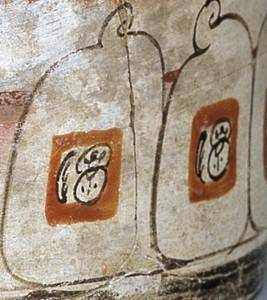
Bags of Cacao Beans
The Maya used cacao as the basis for chocolate drinks and as a form of currency. Three bags of cacao beans are depicted on the step below the principle lord and the youths, probably sons, who sit next to him.
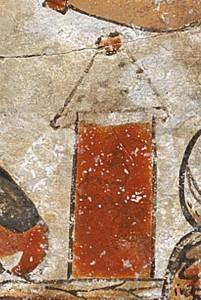
Cacao Vessel
Directly in front of the principle lord is a tall cylindrical vessel, most likely filled with a chocolate beverage.
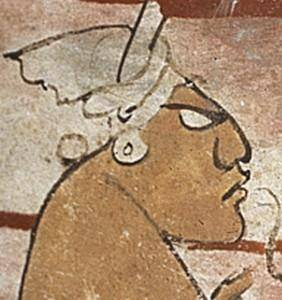
Sloping Forehead
A sloping forehead and elongated head shape were signs of beauty among the Maya elite. Sometimes, an infant’s still soft head was bound between boards to achieve the desired head shape, emphasizing a smooth unbroken line between the nose and the forehead.
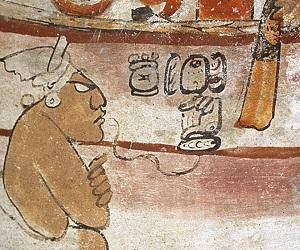
Pink Wash
A delicate pink wash shades the inscriptions and the scene. The colored wash provides the vessel with a distinct look.

Setting
The artist has arranged the ten figures in an interior space that features a two-level platform, curtains, and woven mats.
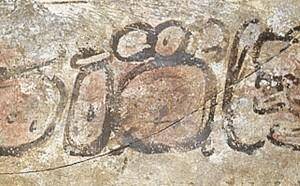
Hieroglyphs
The painted inscription records the name of the large central figure, who is the ruler of the court (Nabnal K’inich Lakam). It also names his father (Yuknoom K’awiil), from the site of Rio Azul in present-day Guatemala. The inscription also identifies the vessel as a drinking vessel for cacao or chocolate.
Funding for object education resources provided by a grant from the Morgridge Family Foundation. Additional funding provided by the William Randolph Hearst Endowment for Education Programs, and Xcel Energy Foundation. We thank our colleagues at the University of Denver Morgridge College of Education.
The images on this page are intended for classroom use only and may not be reproduced for other reasons without the permission of the Denver Art Museum. This object may not currently be on display at the museum.







